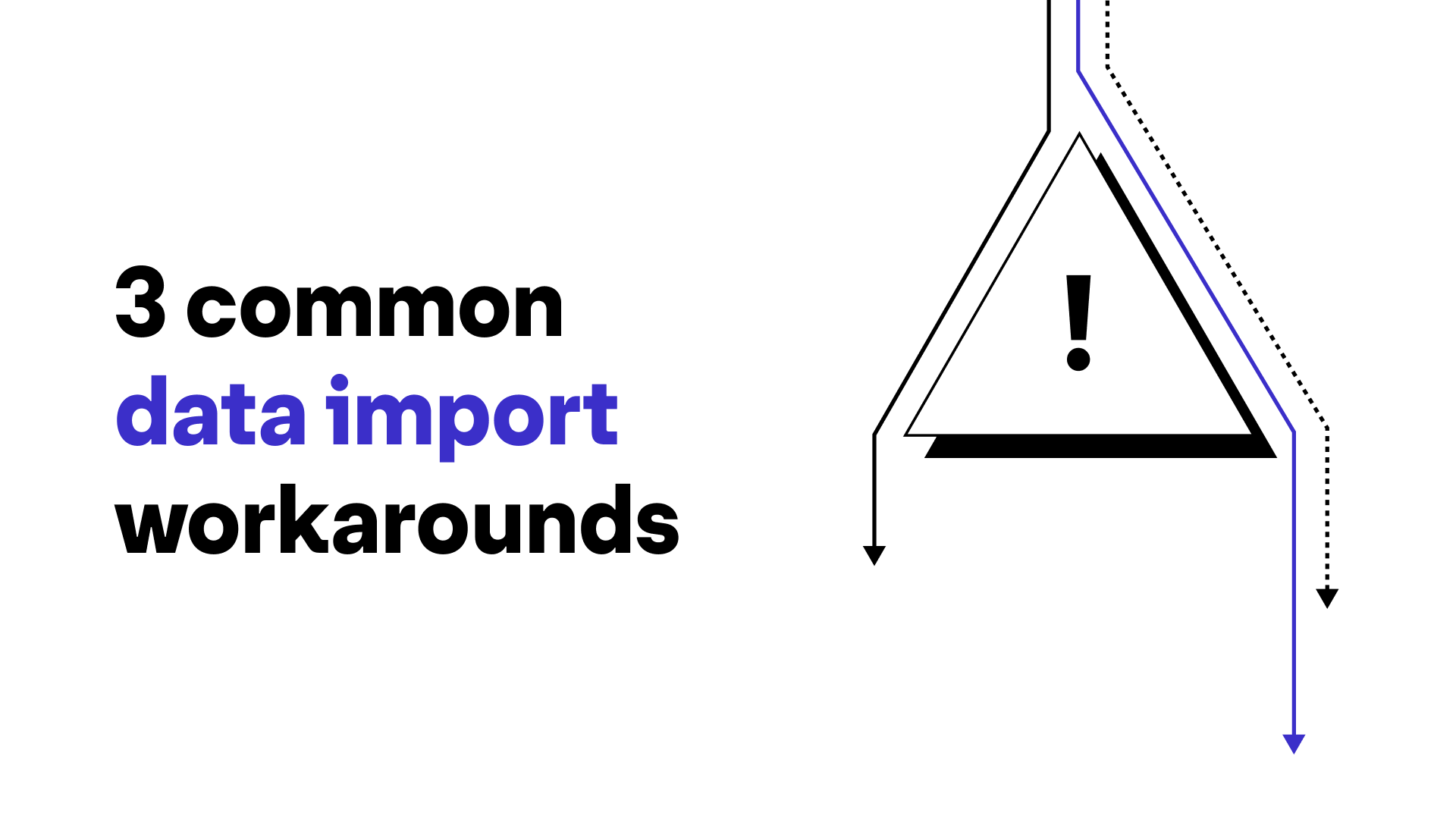3 most common workarounds for data import challenges
Sam Sorbo
Share to

Data might be the power that fuels decision-making, analytics, and growth, but working with your data can be a nightmare. Just importing the data files you need can be a brutal task. I’ve spoken with a lot of companies about the challenges that they’re facing, and I’ve seen firsthand how many businesses struggle with issues like formats, sizes, and other complexities when dealing with data imports.
Trying to successfully import data into your systems can be painfully frustrating, but just because importing data files is hard doesn't mean companies aren't importing data.
Businesses constantly import data with the help of workarounds. Unfortunately, what I keep hearing is that those workarounds often cause data quality issues and come at a high cost. Personnel and manual work costs, supporting engineering resources and long-term maintenance are just the tip of the iceberg. The opportunity cost of lost and delayed revenue can be millions of dollars.
Stop wasting money
Download this free report to discover the missing piece that will help you reduce data errors and maximize revenue opportunities.
If you’ve ever grappled with CSV files that refuse to cooperate, struggled with incompatible data formats, or spent countless hours manually cleaning up data, you're not alone. Here are the most common workarounds that businesses use to solve their data file import challenges:
What workarounds do businesses use to solve data import challenges?
Read on to discover why these solutions aren’t right for the long term and how you can avoid the problems inherent in complicated workarounds.

Paying for services
Some businesses deploy teams of employees or contractors to perform data validation and cleaning so that necessary data can be imported. This is a time-consuming and error-prone process, but it's often the easiest solution, at least at first. This approach comes with large, ongoing personnel costs, and it has a direct impact on the company's bottom line. It can also lead to major time delays in data availability, delaying important decisions and revenue opportunities.
Restrictive end-user templates and rules
One way to minimize manual work for your company is to require that your end-users (your customers, prospects and partners) do the work to make sure data always arrives in perfect condition. Companies ask users to adhere to one very specific spreadsheet format, and even the slightest deviation from that format results in the rejection of the data file import attempt.
Unfortunately, after the second or third attempt, users often give up and move on. The impact of this process on customer satisfaction, conversion rates and missed top-line revenue is one of the most overlooked issues in data integration.
Custom builds
Given the issues above, there are a lot of companies that end up building their own solution to import CSV files, filter data, flag anomalies, and correct information. At first glance, this might seem like a practical choice that gives you the most control over the finished product and frees up data management resources. Unfortunately, custom solutions introduce their own set of difficulties. In fact, if you're dealing with non-trivial needs, building your own solution ties up limited and expensive software engineering resources and usually costs more in the long run.
Building a new feature or functionality means that you’re committing to supporting and maintaining it over time. It typically becomes the responsibility of the team that created it and this ongoing maintenance is almost guaranteed to be a distraction from your core business function.
Data import workarounds vs. data exchange solutions
Even though businesses sometimes rely on workarounds to address data import problems, depending on makeshift solutions can wind up being time-consuming, error-prone, and unsustainable. Whether you're dealing with incompatible file formats, data inconsistencies, or the need for manual data transformation, these workarounds can lead to frustration and slow down or even stop productivity.
How can a data exchange solution solve data import challenges?
A modern data exchange solution will streamline, accelerate and secure your data import processes, improving your business and delivering rapid and sustained ROI.
The right solution will:
Reduce data errors
Accelerate timely decision-making
Reduce in-house development time and cost
Increase data usability
Accelerate time to value
Improve security and compliance
By leveraging the right solution, you can avoid the costs of missed opportunities, delayed revenue and the time and resources involved in creating and maintaining complicated workarounds.
Making sure you have accurate and timely data is a requirement for success, and investing in a data exchange solution can help you stay competitive. If you're looking to overcome data import challenges and improve your data implementation projects, avoid wasting time on workarounds and find the solution that's right for you!
Flatfile has helped hundreds of companies tackle their data file exchange challenges, supporting just about any business or data requirement. Find out how the Flatfile Data Exchange Platform can address your specific data onboarding use case and requirements.
Data onboarding should be fast and painless
Our free in-depth guide will help you address data onboarding challenges and help new customers become customers for life.


